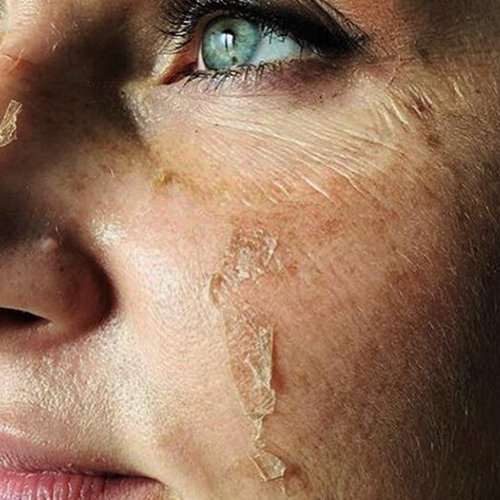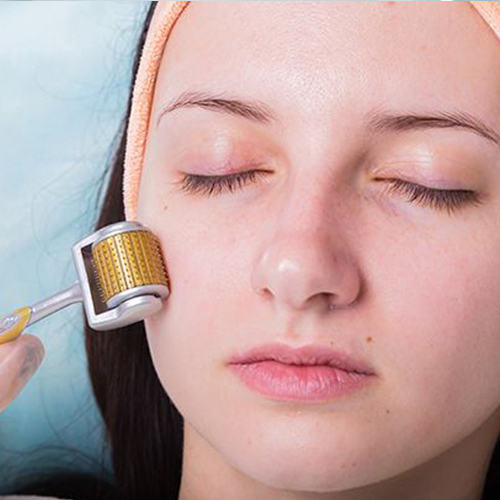Skin Treatment
Peeling
What is chemical peeling ?
A chemical peel, also known as chemexfoliation or derma peeling, uses a chemical solution to improve the appearance of your skin. In this treatment, a chemical solution is applied to your skin, which causes trauma to your skin’s layers. The skin layers eventually peel off revealing more youthful skin.

What Are The Benefits Of A Chemical Peel ?
There are many benefits to receiving a chemical peel. Not only do chemical peels reveal a brighter, smoother and more refined complexion, they also improve the overall look and feel of the skin in just one treatment. Other benefits of receiving a chemical peel include:
- Improving the skin’s colour, clarity, tone and texture
- Stimulating new collagen and healthy skin cell growth, resulting in a radiant complexion
- Reducing discoloration caused by sun damage
- Helping to clear up breakouts
- Smoothing away the look of fine lines and wrinkles
- Increasing hydration of the skin
- Addressing visible skin imperfections and superficial scars
- Enabling skincare products used at home to be more effective because a peel can remove several layers of skin build-up and congestion, allowing products to penetrate deeper into the skin
For long-term results, we recommend a series of three or more chemical peels, spaced four to six weeks apart. The benefit of receiving a series of peels is that this treatment will be able to target the deeper layers of the epidermis, giving your skin an enhanced exfoliation. This type of deep exfoliation can stimulate cellular turnover, resulting in the production of healthy, glowing skin.
The type of chemical peel used will be determined by your clinical aesthetician during your initial consultation based on your skin type, its current condition, your lifestyle, and your desired outcome.
Chemical peel After Care
Here are a few great tips for chemical peel after care, so you can maintain the best results from your treatment:
- Hands Off
The main goal of a chemical peel is to pull up and slough off the damaged skin cells, revealing healthy, glowing skin underneath. When the dead skin starts to shed, avoid touching, picking, or scratching it with your fingers. Let the dead skin shed off naturally, and don’t peel the skin off with your own fingers – using fingers to remove the dead skin can lead to possible scarring. - Pull It Back
Pulling your hair back away from the face with a hair band can help prevent you from touching and keep breakouts at bay. It’s important to allow the skin to go through its naturally peeling process, without accidentally contacting your skin while brushing back your hair. Touching the skin with dirty fingers and hands will only aggregate the new skin and may lead to breakouts. If breakouts do occur, don’t treat them yourself! Have your aesthetician treat them for you or just leave them alone. - Moisturize – But Just Enough to Be Comfortable
After receiving a chemical peel, your skin will be sensitive. There may be certain products in your normal skin care routine that you’ll want to avoid, as they may have active and irritating ingredients. The only two products you will want to use on your skin during the peeling process are sunscreenand just enough of a bland (neutral) moisturizerto be comfortable. The skin feeling and looking dry is part of the peeling process, and your moisturizer won’t be able to correct that.
Our advice is to use little to no moisturizer for the first couple days after treatment. In some cases, there will be a specific post care moisturizer provided at the time of treatment, which is safe to use, and your doctor will walk you through the details. For some people, the only thing that won’t sting the skin is Aquaphor, which is easily available over the counter.
When applying moisturizer to the skin, be careful as well not to rub or scrub it in. Gently apply a thin layer of moisturizer all over the skin multiple times throughout the day, as needed. You’ll be able to go back to your regular skincare routine once the peeling process is complete and skin no longer feels sensitive – generally within a week of receiving your chemical peel.
- Protect Your Skin With SPF
You’ve just gone through the process of getting rid of damaged skin with a chemical peel – so it’s important to avoid damaging the new, vulnerable skin coming through by protecting it with a layer of sunscreen anytime exposure to the sun is possible.
Whether sitting by a window, spending time outside, or in front of a screen of any kind, you need to protect your newly brightened skin. Be sure to choose a physical sunscreen with an SPF of 30 or higher and broad spectrum high safety ratings – your skin will thank you later!
- Let It Peel
Do not remove any of the dry, dead skin with any sort of rubbing, peeling or pulling during the peeling process. Safe exfoliation can be done as soon as skin is no longer hypersensitive. - Lighten Up
Now is a good time to come in for a consultand get a custom home care regimen to maintain your newly brightened skin! You want to be sure to have a great antioxidant, which is your first line of defense against free radicals each and every day. Specialized melanocyte down regulators can help with tougher pigment – see your skin care professional to learn more! - Don’t Worry
It’s also a good idea to just read a book and don’t worry about how your skin looks for a few days. The end result is more than worth the investment
Micro-Needling and Micro-Penning:
What Is Micro – Penning?
Micro-penning instigates the skin’s repair process, resulting in improved texture and softer wrinkles.
What Is Micro-Needling ?
Micro-needling is deeper and more intense, yielding greater change in terms of improved and softer wrinkles than micropenning but with a longer recovery time.

How It Works
During your treatment, the cordless, fractional, automated microneedling device composed of medical-grade stainless steel is used to create controlled micro-injuries to the skin, helping it produce collagen and elastin. Micro-penning also creates micro-channels which allow topical gels, creams and serums to be absorbed more effectively, enhancing their effects in deeper layers of the skin.
Micropenning, or microneedling in its more intense form, is the latest in skin revitalization. These new, innovative treatments offer a safe alternative to common skin resurfacing tools, such as lasers and dermal rollers, and has minimal to no downtime!
Micro-needling not only helps reduce the appearance of fine lines and wrinkles, but also has a positive effect on uneven skin tone and acne scars—improving the skin’s overall appearance to give you a fresher, younger look.
If you would like to learn more about the benefits of micro-needling or micropenning), book your appointment online or call us at 7066834285.
Anticipated Results
Most people can return to their normal, daily activities immediately after their micro-penning treatment. The total healing time depends on the emphasis of the treatment. On average, the skin might be pink 1 to 3 days afterwards. Afterwards, you can enjoy benefits like:
- Wrinkle reduction
- Texture and tone improvement
- Softer, younger-looking skin with fewer signs of aging
- Acne scar and traumatic scar improvement
New collagen production significantly improves the look of your skin, combatting the effects of years of sun damage.
Visible changes in the skin can develop over the course of a few days or several weeks after the treatment. Results continue to improve for up to six months after original treatment, as collagen production continues over time.
As noted above, you tend to notice greater change from micro-needling than micro-penning, but there is a longer recovery time to go along with that
